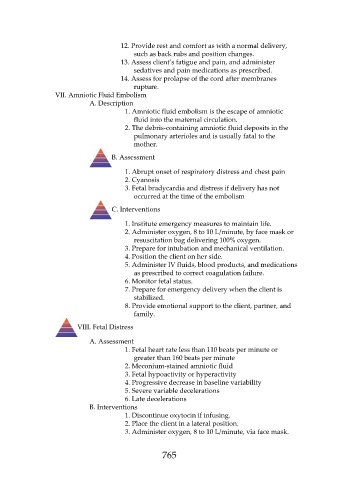Page 765 - Saunders Comprehensive Review For NCLEX-RN
P. 765
12. Provide rest and comfort as with a normal delivery,
such as back rubs and position changes.
13. Assess client’s fatigue and pain, and administer
sedatives and pain medications as prescribed.
14. Assess for prolapse of the cord after membranes
rupture.
VII. Amniotic Fluid Embolism
A. Description
1. Amniotic fluid embolism is the escape of amniotic
fluid into the maternal circulation.
2. The debris-containing amniotic fluid deposits in the
pulmonary arterioles and is usually fatal to the
mother.
B. Assessment
1. Abrupt onset of respiratory distress and chest pain
2. Cyanosis
3. Fetal bradycardia and distress if delivery has not
occurred at the time of the embolism
C. Interventions
1. Institute emergency measures to maintain life.
2. Administer oxygen, 8 to 10 L/minute, by face mask or
resuscitation bag delivering 100% oxygen.
3. Prepare for intubation and mechanical ventilation.
4. Position the client on her side.
5. Administer IV fluids, blood products, and medications
as prescribed to correct coagulation failure.
6. Monitor fetal status.
7. Prepare for emergency delivery when the client is
stabilized.
8. Provide emotional support to the client, partner, and
family.
VIII. Fetal Distress
A. Assessment
1. Fetal heart rate less than 110 beats per minute or
greater than 160 beats per minute
2. Meconium-stained amniotic fluid
3. Fetal hypoactivity or hyperactivity
4. Progressive decrease in baseline variability
5. Severe variable decelerations
6. Late decelerations
B. Interventions
1. Discontinue oxytocin if infusing.
2. Place the client in a lateral position.
3. Administer oxygen, 8 to 10 L/minute, via face mask.
765

